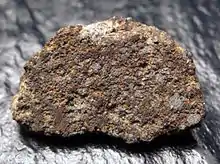| Richardton meteorite | |
|---|---|
 | |
| Type | Chondrite |
| Class | Ordinary chondrite |
| Group | H5 |
| Country | United States |
| Region | Richardton, North Dakota |
| Coordinates | 46°37′30″N 102°16′17″W / 46.62500°N 102.27139°W |
| Observed fall | Yes |
| Fall date | 1918-06-30 |
| TKW | 90 kilograms (200 lb) |
| Strewn field | Yes |
The Richardton meteorite is a 90 kilograms (200 lb) H5 Ordinary chondrite that was seen to fall at 21:48 on 30 June 1918 between Mott, North Dakota and Richardton, North Dakota, United States.[1][2]
Pieces were found in a strewn field of about 9 miles (14 km) by 5 miles (8.0 km) centred on 46°37′30″N 102°16′17″W / 46.62500°N 102.27139°W and oriented north–south.[2] As of December 2012 pieces of this meteorite were for sale online at up to US$80/g.[3]
In 1960 John Reynolds discovered that the Richardton meteorite had an excess of 129Xe, a result of the presence of 129I in the solar nebula.[4][5]
Mineralogy
Classification
See also
References
- ↑ "Richardton". Meteoritical Bulletin Database. Meteoritical Society. Retrieved 24 December 2012.
- 1 2 Quirke, T. T. (Sep–Oct 1919). "The Richardton Meteorite". The Journal of Geology. The University of Chicago Press. 27 (6): 431–448. Bibcode:1919JG.....27..431Q. doi:10.1086/622670. JSTOR 30057982.
- ↑ "Richardton". Meteorites and Related Geology Specimens for Sale. New England Meteoritical Services. Retrieved 24 December 2012.
- ↑ Reynolds, J. (31 March 1960). "Isotopic Composition of Primordial Xenon". Physical Review Letters. 4 (7): 351–354. Bibcode:1960PhRvL...4..351R. doi:10.1103/PhysRevLett.4.351.
- ↑ "John Hamilton Reynolds, 77; Improved Study of Cosmic Ages". Retrieved 25 December 2012.
External links
- A combined chemical-petrological study of separated chondrules from the Richardton meteorite, N.M. Evensen et al., Lamont-Doherty Geological Observatory of Columbia University, Palisades, NY 10964 U.S.A., Earth and Planetary Science Letters doi:10.1016/0012-821X(79)90028-1
This article is issued from Wikipedia. The text is licensed under Creative Commons - Attribution - Sharealike. Additional terms may apply for the media files.